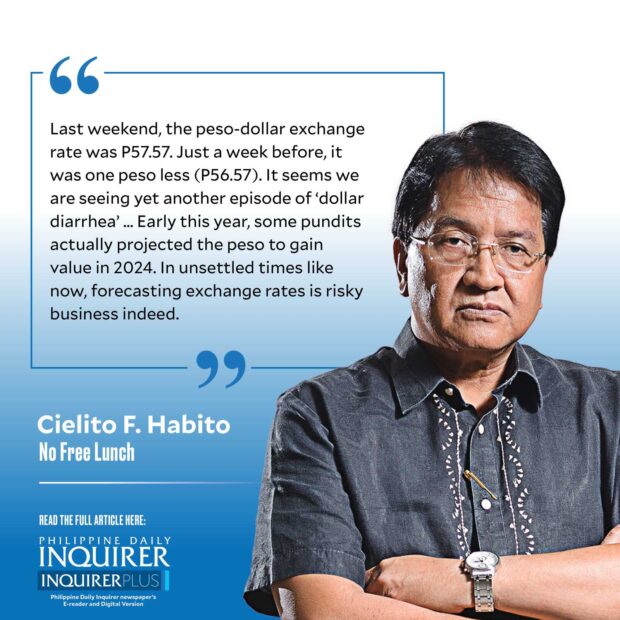The sliding peso

Last weekend, the peso-dollar exchange rate was P57.57. Just a week before, it was one peso less (P56.57). A month before that, it was nearly another peso less (P55.61). That’s 3.5 percent of value lost by our currency in a span of five weeks, fast enough to worry many of us. This is also the highest the exchange rate has been since peaking at P59 in October 2022.
It seems we are seeing yet another episode of “dollar diarrhea,” which I last wrote about at that time our exchange rate reached its record high (“Dollar diarrhea,” 10/4/22). This is bad news for those who have dollar debts to pay, including government itself, and importers who must shell out more pesos for their purchases abroad. It’s also bad news for those traveling abroad who must buy foreign exchange to fund their travels. But it’s good news to those who earn dollars and other foreign currencies, like exporters and overseas Filipino workers, but also for producers for the domestic market, whose competing imports become more expensive and less desirable. It’s also good news for our tourism sector, as more foreigners are attracted to visit us as their dollars go a longer way when spent here.
Currency movements are primarily influenced by sentiments and expectations of those who buy and sell dollars (and other foreign currencies) in our economy, especially businesses and investors, driving supply and demand, hence the price, of dollars. These expectations are in turn based on business and economic prospects as affected by events and factors that could impact economic activity. These factors may either be deliberate, through policies and actions by governments and central banks or due to external events beyond domestic control. The latter are exemplified by recent geopolitical disturbances like the Russia-Ukraine war, escalating hostilities in the Middle East, and rising tensions surrounding our territorial conflict with China, all of which some fear could trigger World War III.
ADVERTISEMENT
Why has the value of the peso fallen so steeply lately? Analysts point out that the depreciation of our peso has not been unique, as it simply moves together with other currencies in the region, all affected by a stronger dollar. This is because most other currencies, especially of developing economies, are closely linked to the US dollar, owing to strong trade and investment relationships with the US economy, the largest economy in the world. When the dollar strengthens or gains value as affected by actions of the US Federal Reserve Bank (Fed) on their domestic interest rates, these other currencies and ours correspondingly depreciate or lose value.
60 hours of free legal aid for the poor
So why has the dollar been getting stronger? Financial analysts point to the recent decision of the Fed to hold back on interest rate cuts that had earlier been widely anticipated worldwide. But higher than expected US inflation led it to postpone the cuts and keep interest rates high, equivalent to keeping money supply in check, the primary tool used by central banks to control inflation (that is, avoid having “too much money chasing too few goods,” a major cause of general price increases or inflation). Is this why the peso has slid rapidly in the past week? There’s apparently more to it than that. I examined the latest comparative currency movements and found that the Philippine peso slid much more steeply than the Thai baht and Malaysian ringgit in the past week, at a time the US dollar actually even weakened slightly (against the Euro, its major reference currency). While the Indonesian rupiah also fell even more steeply after the long Eid al-Fitr holiday last week, it has since reversed and their exchange rate has moved down. Analysts attribute the earlier steep slide to pent-up pressures coming from apprehensions on an inflation rate uptick and recent election results, apart from the US Fed decision.
In our case, Bangko Sentral ng Pilipinas (BSP) Governor Eli Remolona has already admitted that rising tensions between the Philippines and China may be raising investors’ jitters about our country—in what Bloomberg described as possibly the first official confirmation that the escalating dispute is already manifesting in the markets. Data from the Philippine Stock Exchange indeed show consistent and substantial net foreign selling since early April, with cumulative net outflows amounting to nearly P7 billion since April 3. Still, Remolona sees no reason so far to deviate from BSP’s monetary policy outlook, as they are more concerned with smoothing exchange rate volatility rather than suppressing currency market movements. “Unless the movements are very sharp, we tend to allow the adjustment to happen,” he was quoted as saying.
Early this year, some pundits actually projected the peso to gain value in 2024. In unsettled times like now, forecasting exchange rates is risky business indeed.
Your subscription could not be saved. Please try again.
Your subscription has been successful.
EDITORS’ PICK
MOST READ
View comments
